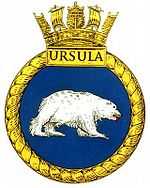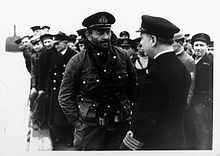HMS Ursula (N59)
 HMS Ursula | |
| Career | |
|---|---|
| Name: | HMS Ursula |
| Builder: | Vickers Armstrong, Barrow-in-Furness |
| Laid down: | 19 February 1937 |
| Launched: | 16 February 1938 |
| Commissioned: | 20 December 1938 |
| Fate: | transferred to Soviet Navy, 26 June 1944 |
| Badge: |
 |
| Career | |
| Name: | V-4 |
| Acquired: | 26 June 1944 |
| Fate: | returned to Britain, early 1950 and scrapped May 1950 |
| General characteristics | |
| Displacement: | Surfaced - 540 tons standard, 630 tons full load Submerged - 730 tons |
| Length: | 58.22 m (191.5 ft) |
| Beam: | 4.90 m (16 ft 1 in) |
| Draught: | 4.62 m (15 ft 2 in) |
| Propulsion: | 2 shaft diesel-electric 2 Paxman Ricardo diesel generators + electric motors |
| Speed: | 11.25 knots (20.8 km/h) max surfaced
10 knots (19 km/h) max submerged |
| Complement: | 27 |
| Armament: | 4 bow internal 21-inch (533 mm) torpedo tubes, 2 external 10 torpedoes 3 anti-aircraft machine guns 1 3-inch (76 mm) gun |
HMS Ursula was a British U class submarine, of the first group of that class, built by Vickers Armstrong, Barrow-in-Furness. She was laid down on 19 February 1937 and was commissioned on 20 December 1938.
She served in home waters in the North Sea, and later in the Mediterranean, before being transferred to the Soviet Navy in 1944.
Career as HMS Ursula
Opening actions
Ursula started the war operating in home waters. On 9 September 1939, she fired the first British submarine torpedoes of the war when attacking the German submarine U-35. The U-boat escaped only to be sunk roughly two months later.
Attacking the Leipzig
On 14 December 1939 Ursula was on patrol off the Elbe estuary when she sighted the German light cruiser Leipzig, escorted by six destroyers. The Leipzig was returning to Kiel to undergo repairs, having been torpedoed and damaged by HMS Salmon. The waters of the Elbe estuary are shallow and to dive deep is a dangerous undertaking involving the risk of getting stuck on a sandbank. Nevertheless, Ursula dived beneath the destroyer screen and got within range of the cruiser, the depth of water being only just enough to allow this manoeuvre. On coming up again to periscope depth, Ursula was found to be within point-blank range of the Leipzig. She fired a salvo of six torpedoes and the two resulting explosions were so close that the Ursula herself was badly shaken. On returning to periscope depth, there was no sign of the cruiser, but it did reveal four of her escorting destroyers closing in at high speed to attack. One of these, the destroyer escort F9, had been hit and was sinking. Once again, risking the sandbanks, the Ursula went deep and managed to evade the inevitable depth charges. Of the cruiser, Leipzig, no further trace was seen, but when the Ursula returned to look for evidence, two of the destroyers were still in the area and engaged, apparently, in a search for survivors. Ursula's commander, Lt.Cdr. G.C. Phillips, was awarded the DSO and promoted. The Leipzig had in fact been missed, the torpedoes had instead hit the F 9. Leipzig made it to port and underwent repair.[1]
Service in the North Sea and Mediterranean
Ursula continued to harass enemy shipping in the North Sea, sinking the German merchant Heddernheim, before being reassigned to operate in the Mediterranean. There she sank the Italian auxiliary submarine chaser V 135 / Togo and the German merchants Sainte Marguerite II (a former French vessel) and Odysseus (the former Norwegian Gran). She also damaged the Italian merchant Sabbia, but was herself damaged by depth charges during a counter-attack by the Italian torpedo boat Generale Carlo Montanari. She also launched unsuccessful attacks against the German transport ships Brook and Tilly L.M. Russ, the Italian troop transport Vulcania and the German submarine U-73. She also attacked and damaged the Italian tanker Beppe, which had to be towed to Tripoli.[2]
The 'Ursula suit'

Early in the war Philips and his crew had become dissatisfied with the conventional garb of oilskins and designed a special form of clothing more suitable for submarines.[3] Ursula's navigating officer, Lt Lakin, was a keen motorcyclist and wore a one-piece motorcycling suit made by Barbour. Philips asked the company to adapt the suit, splitting it into jacket and trousers and adding a hood. The suit became standard watch-keeping clothing in Royal Navy submarines.[4]
Career as Soviet V-4
Ursula was transferred on loan to the Soviet Union on 26 June 1944. She was renamed V-4 "Soviet Svanetia" by the Soviets after a mountainous province in Georgia where the submarine's new commander Yaroslav Iosseliani came from.[5] She had a relatively quiet career scoring one success: on 20 October 1944 she sunk the German submarine chaser UJ-1219.[6] She survived at war and was returned to Britain in early 1950 and was scrapped at Grangemouth in May 1950.
References
- ↑ Leipzig, German-navy.de
- ↑ HMS Ursula, Uboat.net
- ↑ Young, Edward (1954). One of our Submarines, Harmonsdworth, Middlesex: Penguin. page 65.
- ↑ Sea Your History website
- ↑ (Russian) Иосселиани Ярослав Константинович (Iosseliani, Yaroslav Konstantinovich). War Heroes project. Retrieved on March 3, 2009
- ↑ http://www.navypedia.org/ships/germany/ger_esc_kuj.htm
- Colledge, J. J.; Warlow, Ben (2006) [1969]. Ships of the Royal Navy: The Complete Record of all Fighting Ships of the Royal Navy (Rev. ed.). London: Chatham Publishing. ISBN 978-1-86176-281-8. OCLC 67375475.
- Hutchinson, Robert (2001). Jane's Submarines: War Beneath the Waves from 1776 to the Present Day. London: HarperCollins. ISBN 978-0-00-710558-8. OCLC 53783010.
| ||||||||||||||||||||||||||||||||||||||||||||||||||||||